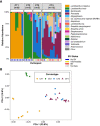Antigen Presenting Cells Link the Female Genital Tract Microbiome to Mucosal Inflammation, With Hormonal Contraception as an Additional Modulator of Inflammatory Signatures
- PMID: 34604114
- PMCID: PMC8482842
- DOI: 10.3389/fcimb.2021.733619
Antigen Presenting Cells Link the Female Genital Tract Microbiome to Mucosal Inflammation, With Hormonal Contraception as an Additional Modulator of Inflammatory Signatures
Abstract
The microbiome of the female genital tract (FGT) is closely linked to reproductive health outcomes. Diverse, anaerobe-dominated communities with low Lactobacillus abundance are associated with a number of adverse reproductive outcomes, such as preterm birth, cervical dysplasia, and sexually transmitted infections (STIs), including HIV. Vaginal dysbiosis is associated with local mucosal inflammation, which likely serves as a biological mediator of poor reproductive outcomes. Yet the precise mechanisms of this FGT inflammation remain unclear. Studies in humans have been complicated by confounding demographic, behavioral, and clinical variables. Specifically, hormonal contraception is associated both with changes in the vaginal microbiome and with mucosal inflammation. In this study, we examined the transcriptional landscape of cervical cell populations in a cohort of South African women with differing vaginal microbial community types. We also investigate effects of reproductive hormones on the transcriptional profiles of cervical cells, focusing on the contraceptive depot medroxyprogesterone acetate (DMPA), the most common form of contraception in sub-Saharan Africa. We found that antigen presenting cells (APCs) are key mediators of microbiome associated FGT inflammation. We also found that DMPA is associated with significant transcriptional changes across multiple cell lineages, with some shared and some distinct pathways compared to the inflammatory signature seen with dysbiosis. These results highlight the importance of an integrated, systems-level approach to understanding host-microbe interactions, with an appreciation for important variables, such as reproductive hormones, in the complex system of the FGT mucosa.
Keywords: HIV; female genital tract; hormonal contraception; host-microbiome interaction; inflammation; microbiome; mucosal immunology.
Copyright © 2021 Byrne, Farcasanu, Bloom, Xulu, Xu, Hykes, Mafunda, Hayward, Dong, Dong, Gumbi, Ceasar, Ismail, Ndung’u, Gosmann, Ghebremichael, Handley, Mitchell, Villani and Kwon.
Conflict of interest statement
The authors declare that the research was conducted in the absence of any commercial or financial relationships that could be construed as a potential conflict of interest.
Figures



Similar articles
-
Update on the Impact of Depot Medroxyprogesterone Acetate on Vaginal Mucosal Endpoints and Relevance to Sexually Transmitted Infections.Curr HIV/AIDS Rep. 2023 Aug;20(4):251-260. doi: 10.1007/s11904-023-00662-0. Epub 2023 Jun 21. Curr HIV/AIDS Rep. 2023. PMID: 37341916 Free PMC article. Review.
-
The relationship between sex hormones, the vaginal microbiome and immunity in HIV-1 susceptibility in women.Dis Model Mech. 2018 Aug 28;11(9):dmm035147. doi: 10.1242/dmm.035147. Dis Model Mech. 2018. PMID: 30154116 Free PMC article. Review.
-
The Contribution of Cervicovaginal Infections to the Immunomodulatory Effects of Hormonal Contraception.mBio. 2015 Sep 1;6(5):e00221-15. doi: 10.1128/mBio.00221-15. mBio. 2015. PMID: 26330510 Free PMC article.
-
Diversity of vaginal microbiota in sub-Saharan Africa and its effects on HIV transmission and prevention.Am J Obstet Gynecol. 2019 Feb;220(2):155-166. doi: 10.1016/j.ajog.2018.10.014. Epub 2018 Oct 12. Am J Obstet Gynecol. 2019. PMID: 30321529 Free PMC article. Review.
-
An updated review on the effects of depot medroxyprogesterone acetate on the mucosal biology of the female genital tract.Am J Reprod Immunol. 2021 Sep;86(3):e13455. doi: 10.1111/aji.13455. Epub 2021 Jun 12. Am J Reprod Immunol. 2021. PMID: 33991137 Free PMC article. Review.
Cited by
-
The female reproductive tract microbiotas, inflammation, and gynecological conditions.Front Reprod Health. 2022 Aug 9;4:963752. doi: 10.3389/frph.2022.963752. eCollection 2022. Front Reprod Health. 2022. PMID: 36303679 Free PMC article. Review.
-
Understanding the Associations of Urogenital Microbiomes With Fertility and In Vitro Fertilization.Am J Reprod Immunol. 2025 Feb;93(2):e70035. doi: 10.1111/aji.70035. Am J Reprod Immunol. 2025. PMID: 39945201 Free PMC article. Review.
-
Increased genital mucosal cytokines in Canadian women associate with higher antigen-presenting cells, inflammatory metabolites, epithelial barrier disruption, and the depletion of L. crispatus.Microbiome. 2023 Jul 25;11(1):159. doi: 10.1186/s40168-023-01594-y. Microbiome. 2023. PMID: 37491398 Free PMC article.
-
Comparative analysis of vaginal microbiota sampling using menstrual cups and high vaginal swabs in pregnant women living with HIV-1 infection.Front Cell Infect Microbiol. 2023 May 9;13:1190160. doi: 10.3389/fcimb.2023.1190160. eCollection 2023. Front Cell Infect Microbiol. 2023. PMID: 37228662 Free PMC article.
-
Female reproductive health impacts of Long COVID and associated illnesses including ME/CFS, POTS, and connective tissue disorders: a literature review.Front Rehabil Sci. 2023 Apr 28;4:1122673. doi: 10.3389/fresc.2023.1122673. eCollection 2023. Front Rehabil Sci. 2023. PMID: 37234076 Free PMC article. Review.
References
Publication types
MeSH terms
Grants and funding
LinkOut - more resources
Full Text Sources
Medical
Miscellaneous

